For the category of enthusiastic scientists who are interested in the existence of extraterrestrial worlds suitable for exploration, the well-known phrase: "Is there life on Mars, is there life on Mars", has ceased to be relevant today. It turned out that there are worlds within the Solar System that are much more interesting in this aspect than the Red Planet. A vivid example of this is Saturn’s largest satellite, Titan. It turned out that this heavenly body is very similar to our planet. The information that scientists have today allows for the existence of a scientific version that life on Satan’s satellite on Titan is quite a fact.
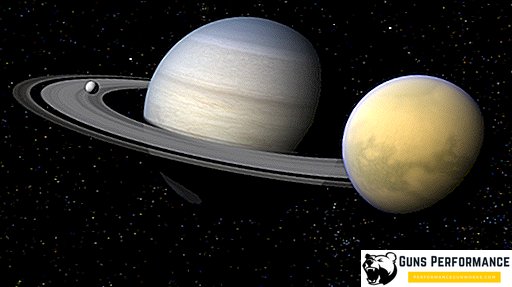
What is so interesting for earthlings Titan?
After a man for decades trying unsuccessfully to find a world within our solar system that at least resembled our Earth from afar, information about Titan instilled hope in the scientific community. Scientists have become interested in this celestial body, beginning in 2005, when an automatic Huygens probe landed on the surface of one of the largest satellites of the Solar System. For the next 72 minutes, the onboard photo and video camera of the spacecraft transmitted to the Earth a photo of the surface of this object and other video materials about this distant world. Even for such a limited time allotted for instrumental research of a distant satellite, scientists were able to obtain an exhaustive amount of information.

Landing on the surface of Titan was carried out in the framework of the international program "Cassini-Huygens", aimed at the study of Saturn and its satellites. Launched back in 1997, the Cassini automatic interplanetary station is a general development of ESA and NASA for a detailed study of Saturn and the surrounding area of this planet. After 7 years of flying across the expanses of the solar system, the station delivered the Huygens space probe to Titan. This unique device is the fruit of the joint work of experts from NASA and the Italian space agency, whose team had placed great hopes on this flight.
The results that scientists obtained from the working station "Cassini" and from the board of the probe "Huygens" turned out to be invaluable. Despite the fact that the distant satellite appeared before the eyes of earthlings as a huge silent kingdom of ice, the subsequent detailed study of the surface of the object changed the perception of Titan. In the photographs obtained using the Huygens probe, it was possible to disassemble the surface of the satellite of Saturn, which mainly consisted of solid water ice and sedimentary layers of organic nature, in the smallest detail. It turned out that the dense and impenetrable atmosphere of a distant satellite has almost the same composition as the terrestrial air-gas envelope.
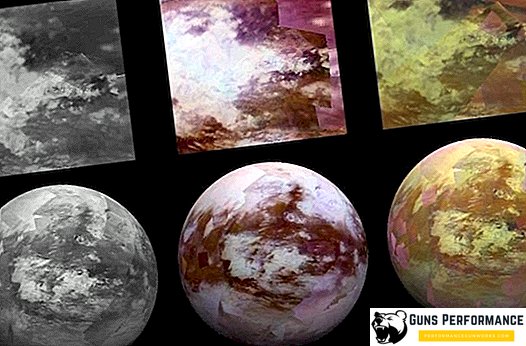
In the future, Titan scientists threw another serious bonus. For the first time in the history of the exploration and study of extraterrestrial space outside the Earth, the liquid matter of the same nature that was on planet Earth in the early years of its existence was found. The relief of the celestial body complements the vast ocean, numerous lakes and seas. All this gives reason to believe that we are dealing with a celestial body, which could be another oasis of life in our solar system. Studies of the composition of the atmosphere and liquid medium of the satellite of Saturn revealed the presence of essential substances for the life of organisms. It is assumed that under certain conditions in the process of studying this celestial body, living organisms can be detected on Titan.
In this regard, the subsequent study of the largest satellite of Saturn becomes relevant. There is a high probability that, along with Mars, it is Titan that could become the second cosmic home for human civilization.
Academic view of Titan
The size of Titan allows it to be with the planets of the solar system. This celestial body has a diameter of 5152 km, which is larger than the diameter of Mercury (4879 km) and slightly less than Mars (6779 km). The mass of Titan is 1.3452 · 1023 kg, which is 45 times less than the mass of our planet. On the mass of the satellite of Saturn is the second in the solar system, behind the satellite of Jupiter - Ganymede.

Despite its impressive size and weight, Titan has a low density, only 1.8798 g / cm³. For comparison, the density of the mother planet Saturn is only 687 k / m3. Scientists have identified a weak gravitational field from a satellite. The force of attraction on the surface of Titan is 7 times weaker than the earthly parameters, and the acceleration of gravity is the same as on the Moon - 1.88 m / s2 versus 1.62 m / s2.
A characteristic feature is the position of Titan in space. The largest satellite of Saturn rotates around its mother planet in an elliptical orbit at a speed of 5.5 km / s, being outside the region of the rings of Saturn. The average distance from Titan to the surface of Saturn is 1, 222 million km. This entire system is located at a distance of 1 billion 427 million km from the Sun, which is 9.5 times longer than the distance between our central luminary and the Earth.
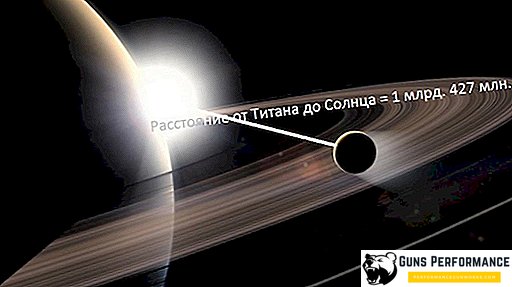
Like our satellite, the "Moon of Saturn" is always turned to it by one side. This is caused by the synchronism of the satellite's rotation around its own axis with the period of the orbit of Titan around the mother planet. A complete revolution around Saturn, its largest satellite makes for 15 Earth days. Due to the fact that Saturn and its satellites have a rather high angle of inclination of the axis of rotation to the axis of the ecliptic, there are seasons on the surface of Titan. Every 7.5 Earth years on the satellite of Saturn, the summer gives way to a cold winter period. According to astronomical observations today on the side of Titan, which faces Saturn, is autumn. Soon the satellite will disappear from the sun’s rays behind the mother planet and titan autumn will be replaced by a long and fierce winter.
Temperatures on the satellite surface vary within minus 140-180 degrees Celsius. The data obtained from the board of the Huygens space probe revealed a curious fact. The difference between polar and equatorial temperatures is only 3 degrees. This is explained by the presence of a dense atmosphere, which prevents the effects of sunlight on the surface of Titan. Despite the high density of the atmosphere, due to the low temperatures, there is no liquid precipitation on Titan. In winter, the surface of the satellite covers the snow from ethane, water vapor particles and ammonia. This is only a small fraction of what we know about Titan. Interesting facts about the largest satellite of Saturn relate to literally any field, from astronomy, climatology and glaciology, to microbiology.
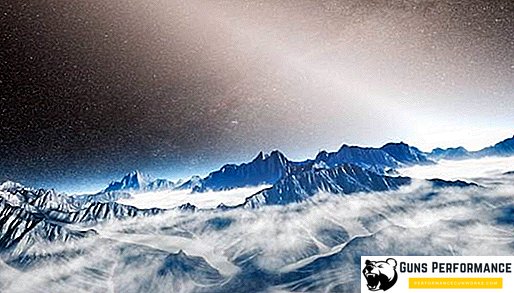
Titan in all its glory
Until recently, most of the information about the satellite of Saturn was based on visual observations obtained from the Voyager space probe, which swept past in 1980 at a distance of 7000 km. The Hubble telescope slightly lifted the veil of secrecy about this space object. To get an idea of the satellite's surface did not allow its dense atmosphere, which in density and thickness is inferior only to the Venusian and terrestrial air-gas envelope.
The mission of the Cassini automatic station in 2004 helped to remove the mist that reigned over this celestial body. For four years, the device was in orbit of Saturn, carrying out consistent photographing of his satellites and Titan as well. Research from the Cassini probe was carried out with the help of a camera with an infrared filter and a special radar. The photos were taken from different angles at a distance of 900-2000 km from the surface of the satellite.
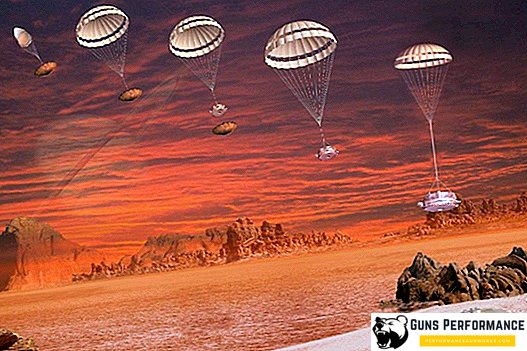
The culmination of the study of Titan was the landing on its surface of the Huygens probe, named after the discoverer of the satellite of Saturn. The device, having entered the dense layers of the atmosphere of Titan, descended by parachute for 2.5 hours. During this time, the probe’s equipment studied the composition of the satellite’s atmosphere, photographed its surface from a height of 150, 70, 30, 15, and 10 kilometers. After a long descent, the space probe landed on the surface of the Titan, buried 0.2-0.5 meters in dirty ice. After landing the Huygens worked for a little more than an hour, transmitting a mass of useful information directly to the Earth via the Cassini AMS directly from the satellite surface. Thanks to photographs taken from the board of the Cassini AMS and the Huygens probe, the team of researchers produced a map of Titan. In addition, scientists now possessed detailed information about its atmosphere, data on surface climate and terrain features.
Satellite atmosphere
In the situation with Titan, for the first time in the process of studying and studying the celestial bodies of the solar system, the scientist had the opportunity to study the atmosphere in detail. As expected, the satellite of Saturn has a dense and well-developed atmosphere, which not only in many ways resembles the gas shell of the Earth, but also surpasses it in mass.
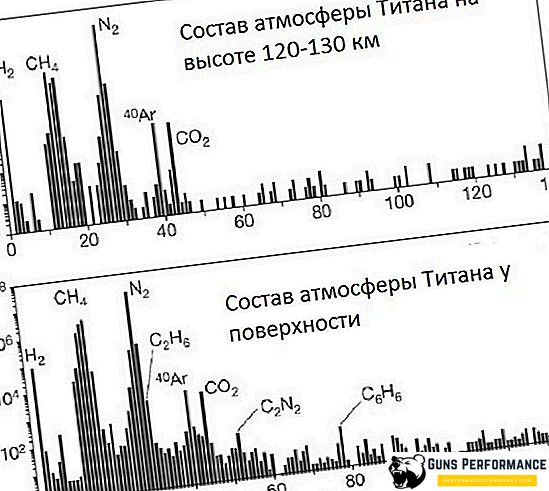
The thickness of the atmospheric layer of Titan was 400 km. Each layer of the atmosphere has its own composition and concentration. The gas composition is as follows:
- 98.6% leaves nitrogen N;
- 1.6% in the atmosphere is methane;
- a small amount of ethane, acetylene compounds, propane, carbon dioxide and carbon monoxide, helium and cyan.
The concentration of methane in the atmosphere of the satellite, starting from an altitude of 30 km, changes downward. As the satellite approaches the surface, the amount of methane decreases to 95%, while the concentration of ethane increases to 4–4.5%.
A characteristic feature of the air-gas layer of the satellite Titan is its anti-greenhouse effect. The presence of hydrocarbon organic molecules in the lower atmosphere neutralizes the greenhouse effect created by the huge concentration of methane. As a result, the surface of a celestial body is uniformly cooled due to the presence of hydrocarbons. These same processes and the gravitational field of Saturn, cause the circulation of the atmosphere of Titan. This picture contributes to the formation of active climatic processes in the atmosphere of the satellite of Saturn.
It should be noted that the atmosphere of the satellite is constantly losing weight. This is due to the absence of a powerful magnetic field in a celestial body, which is unable to hold the air-gas envelope, which is under the constant influence of the solar wind and the gravitational forces of Saturn. To date, the atmospheric pressure on the satellite-ringed giant is 1.5 atm. This invariably affects weather conditions, which vary with the concentration of gases in the atmosphere of Titan.
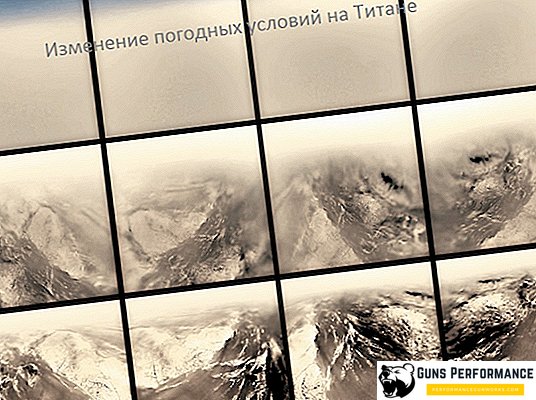
The main work on creating weather on Titan is performed by dense clouds, which, unlike the terrestrial air masses, consist of organic compounds. These atmospheric formations are the source of precipitation on the largest satellite of Saturn. Due to low temperatures, the atmosphere of a celestial body is dry. The greatest concentration of cloudiness is found in the polar regions. Because of the low temperatures, the humidity in the atmosphere is extremely low, so precipitation on Titan is methane ice crystals and frost, consisting of nitrogen, ethane, and ammonia compounds.
The surface of Titan and its structure
Saturn's satellite has not only an interesting atmosphere. Its surface is an extremely curious object from the point of view of geology. Under a thick blanket of methane, photo lenses and cameras of the Huygens space probe found whole continents separated by numerous lakes and seas. As on Earth, there are plenty of rocky and mountainous formations on the continents, there are deep crevices and depressions. They are replaced by vast plains and valleys. In the equatorial part of the celestial body, particles of hydrocarbonate and water ice form a vast area of dunes. It is assumed that the Huygens space probe has made a landing in one of these dunes.
Full similarity with the living planet adds the presence of a liquid structure. On Titan, rivers that have sources, winding channels and deltas — the places where the rivers flow into the sea basins — have been discovered. According to the data taken from the photographs, some Titan rivers have a channel length of more than 1000 km. Virtually all of the liquid mass of Titan is concentrated in marine basins and lakes, which occupy an impressive area - up to 30-40% of all surface areas of this celestial body.
Proof of the presence of large clusters of liquid medium on the surface of the satellite was a huge bright spot, which for a long time confused astronomers. Subsequently, it was proved that the bright area on Titan is a huge pool of liquid hydrocarbons, called the Kraken Sea. By area, this imaginary reservoir is larger than the largest lake on Earth - the Caspian Sea. Another equally interesting object is the Sea of Liegei - the largest natural reservoir for liquid methane and ethane.

Accurate information on the composition of the liquid medium of the seas and lakes of Titan was obtained thanks to the work of AMC "Casssini". Using data from photographs and computer simulations, the composition of the liquid on Titan was determined under terrestrial conditions:
- ethane is 76-80%;
- propane in the seas and lakes of Titan 6-7%;
- methane accounts for 5-10%.
In addition to the basic elements represented as frozen gases, hydrogen cyanide, butane, butene and acetylene are present in the liquid. The main accumulation of water on Titan has a slightly different nature from the earth's form. On the surface of the satellite, huge amounts of superheated ice deposits consisting of water and ammonia were found. It is assumed that under the surface may be vast natural reservoirs filled with liquid water with ammonia dissolved in it. In this aspect, the internal structure of the satellite is also interesting.

Today there are various versions of the internal structure of Titan. As is the case with all the terrestrial planets, it has a solid core, not iron-nickel, as on the first four planets of the solar system, but a stone one. Its diameter is approximately 3400-3500 km. Next comes the fun part. Unlike the Earth, where the mantle begins after the core, on Titan this space is filled with dense pressed layers of water ice and methane hydrate. There is probably a liquid layer between the individual layers. However, despite its coldness and stony nature, the satellite is in the active phase and tectonic processes are observed on it. This is facilitated by tidal forces that are caused by Saturn’s gigantic gravity.
Possible future of Titan
Judging by the data of studies conducted in the last decade, humanity is dealing with a unique object of the solar system. It turned out that Titan is the only celestial body, in addition to the Earth, which is characterized by all three types of activity. On the satellite of Saturn there are traces of constant geological activity, which is a confirmation of his live tectonic activity.
The nature of the surface of Titan is also of great interest. Its structure, composition and relief speak in favor of the fact that the surface of the satellite of Saturn is in constant motion. Here, like on Earth, under the influence of winds and precipitation, soil erosion is observed, weathering of rocks and sedimentation occur.
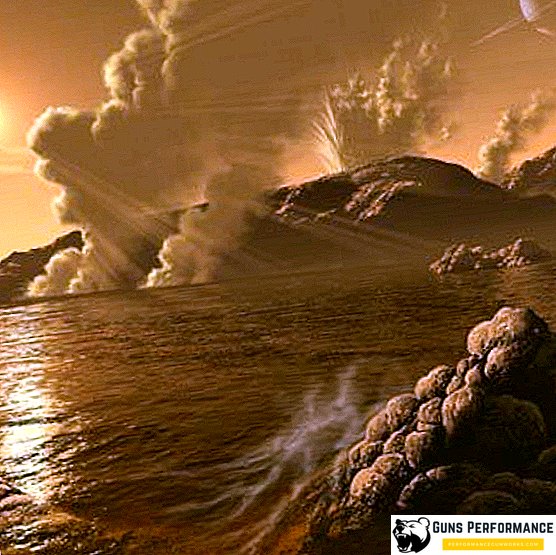
The composition of the atmosphere of the satellite and the circulation processes occurring in it formed the climate on Titan. All of these signs speak in favor of the fact that life can exist on Titan under certain conditions. Naturally, it will be a different form of life from earthly organisms, but its very existence will become a colossal discovery for humanity.












